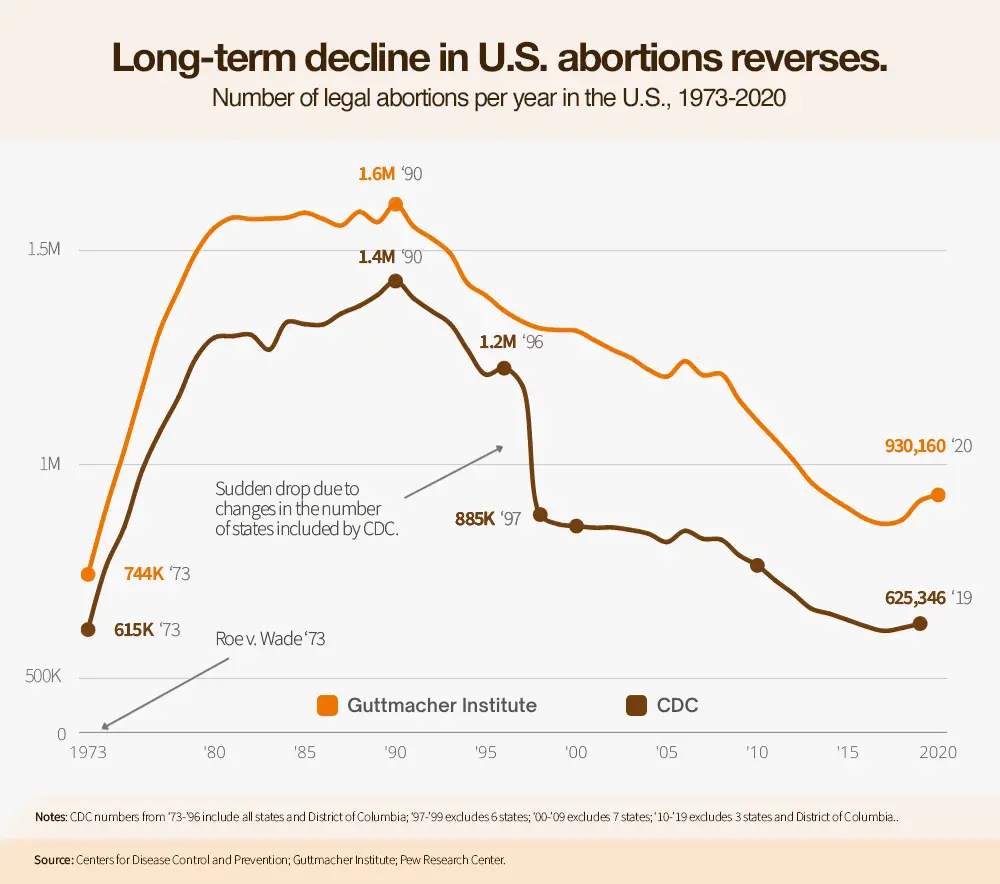Abortion Statistics in 2025 (Latest U.S. Data)
This is an opinion-free overview of the latest abortion statistics.
The Guttmacher Institute and the Centers for Disease Control and Prevention (CDC) offer the primary abortion statistics in the U.S.
Guttmacher contacts every abortion provider, while CDC relies on voluntary reporting, which doesn’t include every state.
Thus, Guttmacher data is mainly used for quantitative data, while CDC is for qualitative.
Abortion Statistics
Overview of statistics on abortion:
- About 930,160 legally induced abortions are provided annually in the U.S.
- 20.6% of all pregnancies in the U.S. end in abortion.
- 61% of Americans believe abortion should be legal all or most of the time.
- The top reason for abortion (25%) is not being ready for a child, <0.5% victim of rape.
- 93% of abortions occur during the first trimester, at or before 13 weeks of gestation.
- The majority of American women (57.1%) who have abortions are in their 20s.
- There are 1,687 healthcare facilities in the U.S. that provide legal abortion services.
- The median self-pay cost for medication abortion in the U.S. is $568.
- 9.3% of legal abortions are performed on women outside their state of residence.
- 62% of abortion patients have a religious affiliation.
1. About 930,160 legally induced abortions are provided annually in the U.S.
According to the Guttmacher Institute’s latest U.S. abortions statistics (2022), approximately 930,160 legally induced abortions were provided in 2020 in the U.S. (1)
This is an 8% increase from 2017.
| No. of Abortions in 2020 (latest) | No. of Abortions in 2019 | No. of Abortions in 2017 |
| 930,160 | 916,460 | 862,320 |
The number of abortions per year increased in all four regions in the U.S between 2017 and 2020.
| Abortions in West | Abortions in Midwest | Abortions in South | Abortions in Northeast |
| 12% increase | 10% increase | 8% increase | 2% increase |
The largest increase in the number of abortions by year was 12% in the West, 10% in Midwest, 8% in the South, and 2% in the Northeast. (1)
Similarly, the abortion rate increased to 14.4 abortions per 1,000 women in 2020. This is a 7% increase from 2017.
The long-term decline of legal abortions in the U.S. reverses.
According to the latest abortion statistics by year from Guttmacher and CDC, the long-term decline in U.S. abortions reverses. (1, 2)

The annual number of abortions skyrocketed in 1973 after Roe v. Wade legalized the health procedure. The peak of abortion per year was 1.6 million in 1990, according to Guttmacher. (2)
Since the peak, there has been a slow and steady decline in the trend. Although CDC and Guttmacher’s numbers are different, they both show a similar trend throughout history.
2. 20.6% of all pregnancies in the U.S. end in abortion.
According to Guttmacher’s statistics on abortion ratios, the abortion ratio in the U.S. is 20.6% of abortions per 100 pregnancies. This means about one in five pregnancies ends in abortion. (1, 3)
| U.S. Abortion Ratio 2020 | U.S. Abortion Ratio 2017 | U.S. Abortion Ratio 2011 |
| 20.6 per 100 pregnancies | 18.4 per 100 pregnancies | 21.2 per 100 pregnancies |
The U.S. abortion ratio has increased 12% between 2017 and 2020.
According to Guttmacher’s statistics on abortion rates (2020), the abortion rate in the U.S. is 14.4 abortions per 1,000 women ages 15 to 44. This is a 7% increase from 2017. (1)
| U.S. Abortion Rate 2020 | U.S. Abortion Rate 2019 | Global Abortion Rate 2019 |
| 14.4 per 1,000 women | 14.2 per 1,000 women | 39 per 1,000 women |
Historically, the U.S. abortion rate has been declining since 1981, when it was 29.3 per 1,000 women. But the last numbers still show a reversal of the abortion rate decline.
States/regions with the highest abortion rates are the District of Columbia (48.9%), New Jersey (29.2%), and New York (28.8%). (1)
| State | Abortion Rate per 1,000 Women | Number of Abortions In 2020 |
| District of Columbia | 48.9% | 9,410 |
| New Jersey | 29.2% | 48,830 |
| New York | 28.8% | 110,360 |
| Maryland | 25.9% | 30,750 |
| Illinois | 21.3% | 52,780 |
| Florida | 19.7% | 77,400 |
| California | 19.2% | 154,060 |
| Georgia | 18.9% | 41,620 |
| Nevada | 17.9% | 11,010 |
| Michigan | 16.8% | 31,510 |
Interestingly enough, a high abortion rate by state doesn’t necessarily mean a higher total number of abortions.
The states with the highest number of abortions in 2020 were California with 154,060 abortions, New York with 110,360 abortions, and Florida with 77,400 abortions.
3. 61% of Americans believe abortion should be legal all or most of the time.
According to Pew Research Center statistics on abortions (2022), 61% of Americans say abortion should be legal all or most of the time. (4)
| Legal In All Cases | Legal In Most Cases | Illegal In All Cases | Illegal In Most Cases |
| 19% of Americans | 42% of Americans | 8% of Americans | 29% of Americans |
The numbers in the table above do not add up to the full 100% because 2% of missing are Americans who didn’t respond to the study.
The abortion research also found that the majority (73%) say abortion should be legal if a woman’s life or health is at risk, while 14% say it depends, and 11% say it should be illegal. (4)
| Abortion Should Be Legal If | Legal | It Depends | Illegal |
| Threat to woman’s life or health | 73% | 14% | 11% |
| Pregnancy is the result of rape | 69% | 14% | 15% |
| Baby likely to have severe disabilities | 53% | 25% | 19% |
69% of U.S. adults say that abortion should be legal if the pregnancy is the result of rape, while 14% say it depends, and 15% say it should be illegal.
53% of U.S. adults say that abortion should be legal if the baby is likely to have severe disabilities or health problems, while 25% say it depends, and 19% say it should be illegal.
4. The top reason for abortion (25%) is not being ready for a child, <0.5% victim of rape.
According to Guttmacher’s reasons for abortion statistics, the most common reason for abortion (25%) in the U.S. is not being ready for a child. Followed by not being able to afford a baby (23%). (5)
| Reasons for Abortion | Percentage |
| Not ready for a child | 25% |
| Can’t afford a baby | 23% |
| Have completed childbearing | 19% |
| Don’t want to be a single mother | 8% |
| Not mature enough to raise a child | 7% |
| Would interfere with education/career | 4% |
| Physical health problems | 4% |
| Fetal health problems | 3% |
| Was a victim of rape | <0.5% |
| Other | 6.5% |
About 19% of women reasoned that they have completed their childbearing or they have other people depending on them. (5)
Less than 0.5% of women had an abortion because they were a victim of rape.
Another <0.5% of abortions were caused because the husband, partner, or parents wanted them to have an abortion.
5. 93% of abortions occur during the first trimester, at or before 13 weeks of gestation.
According to CDC abortion trimester statistics, 93% of abortions occur during the first trimester, at or before 13 weeks of gestation. (6)
| ≤6 Weeks | 7–9 Weeks | 10–13 Weeks | 14–15 Weeks | 16–17 Weeks | 18–20 Weeks | ≥21 Weeks |
| 43% | 36.4% | 13.4% | 2.9% | 1.7% | 1.6% | 1% |
About 6% of abortions occur between 14 and 20 weeks of pregnancy and 1% of abortions are performed at 21 weeks or more of gestation. (6, 2)
This CDC data is based on 47 states, the District of Columbia, and New York City, excluding California, Maryland, and New Hampshire.
For the first time, medication abortion accounted for more than half of all abortions in the U.S.
According to Guttmacher’s preliminary data on abortion types, the first time, 54% of all clinical abortions were medical abortions. (7)
| Medication In 2020 | Surgical In 2020 |
| 54% of abortions | 46% of abortions |
The use of medication abortion has been on an upwards trend since the instruction of the drug 20 years ago.
| Medication In 2020 | Medication In 2017 | Medication In 2014 |
| 54% of abortions | 39% of abortions | 31% of abortions |
The medication abortion usage has been growing with a compound annual growth rate (CAGR) of 22.07% since the introduction of the drug.
According to Guttmacher’s abortion data, the proportion of medication abortion use is not expected to fall below 50% in the future. (7)
6. The majority of American women (57.1%) who have abortions are in their 20s.
According to CDC abortion demographic statistics, 57.1% of women who have abortions are in their 20s and 30.2% are in their 30s. (2)
| Ages <15 | Ages 15–19 | Ages 20–24 | Ages 25–29 | Ages 30–34 | Ages 35–39 | Ages ≥40 |
| 0.2% | 8.7% | 27.8% | 29.3% | 19.4% | 10.8% | 3.8% |
The data shows that teen abortion (ages 13-19) accounts for 8.9% and women in their 40s account for 3.7%.
| Gen Z Ages 7-24 | Millennials Ages 25-39 | Gen X Ages 40+ |
| 36.7% of abortions | 59.5% of abortions | 3.8% of abortions |
By age generations, Gen Z accounts for 36.7% of abortions, Millennials 59.5% of abortions, and Gen X 3.8% of abortions.
There are no definitive generation age ranges, but according to Pew Research data, the most adaptable age ranges are Gen Z ages 7-24, Millennials ages 25-39, and Genx ages 40 and above. (8)
| 0 Previous Abortions | 1 Previous Abortion | 2 Previous Abortions | >=3 Previous Abortions |
| 58.2% of women | 23.8% of women | 10.5% of women | 7.5% of women |
According to CDC statistics on repeat abortions, for 58.2% of U.S. women, it was the first time they had an abortion. (6)
For 23.8%, it was their second abortion, 10.5%, their third abortion, and for 7.5%, their fourth or more abortion.
| White | Black | Hispanic | Other |
| 33.4% of women | 38.4% of women | 21% of women | 7.2% of women |
The CDC abortion statistics by race/ethnicity show that out of all women who had abortions in 2019 (latest data), 38.4% were Black, 33.4% White, 21% Hispanic, and 7.2% of other races and ethnicities. (6)
7. There are 1,687 healthcare facilities in the U.S. that provide legal abortion services.
According to Guttmacher’s abortion clinics statistics (2020), there are 1,687 healthcare facilities in the U.S. that provide legal abortions. (1)
| Abortion Providers In 2020 | Abortion Providers In 2017 | Abortion Providers In 2014 | Abortion Providers In 1982 |
| 1,687 facilities | 1,587 facilities | 1,671 facilities | 2,908 facilities |
According to Pew Research abortions statistics in the U.S., the total number of abortion providers has been slowly declining since 1982, when there were 2,908 facilities offering abortion. (2)
The downward trend continued to 2017, with 1587 facilities.
But with the recent increase in the number of abortions across the U.S., the number of abortion providers has increased to 1,867 facilities.
The data includes only the provision of abortion overseen by clinicians and does not account for self-managed abortion.
8. The median self-pay cost for medication abortion in the U.S. is $568.
According to ANSIRH abortion cost statistics (2021), the median self-pay cost for medication abortion in the U.S. is $568, first-trimester procedural abortion is $625, and second-trimester procedural abortion is $775. (9)
| Type | Medication Abortion | Procedural Abortion | Procedural Abortion |
| Period | Up to 10 Weeks | First Trimester | Second Trimester |
| Latest Year | 2021 | 2021 | 2021 |
| Median Cost | $568 | $625 | $775 |
According to the abortion price report, most patients self-pay for their abortion.
Between 2017-2021, median costs for medication abortion in the U.S. increased by 15%, first-trimester procedural abortion costs increased by 31%, and second-trimester abortion costs decreased by 17%. (9)
The ANSIRH cost of abortion data suggests that insurance acceptance for abortion services varies widely by state and has been declining between 2017 to 2021.
| Any Insurance 2021 | Any Insurance 2020 | Any Insurance 2019 | Any Insurance 2018 | Any Insurance 2017 |
| 71% of facilities | 79% of facilities | 78% of facilities | 81% of facilities | 82% of facilities |
The reduction in insurance acceptance over time is likely caused by state laws that increasingly restrict insurance providers from covering abortion services. (9)
The proportion of health care facilities accepting any form of insurance coverage declined from 82% in 2017 to 71% in 2021.
9. 9.3% of legal abortions are performed on women outside their state of residence.
According to CDC abortion statistics by the state of residence, 9.3% of all abortions are performed on women outside their state of residence. (2)
| Different State 2019 | Different State 1974 | Different State 1973 | Different State 1972 |
| 9.3% of abortions | 11% of abortions | 21% of abortions | 41% of abortions |
The abortion rate outside the state of residence has been stable during the last years. Much of it is thanks to the broad availability of the services across states. (2)
The share of abortions outside of the state of residence was 41% in 1972, before the Roe v. Wade decision that stopped states from banning abortion.
In 1973, the number dropped by almost 2 times to 21%, and in 1974 it was already 11%.
According to Pew Research, many states will further restrict access to abortion in the future, causing more women from states with less abortion access to travel to states with more access. (2)
10. 62% of abortion patients have a religious affiliation.
According to the Guttmacher abortion by religion statistics, the majority (62%) of abortion patients have a religious affiliation. (10)
| Catholic | Mainline Protestant | Evangelical Protestant | Other Religion | No Religion |
| 24% | 17% | 13% | 8% | 38% |
Seventeen percent identify as mainline Protestant, 13% as evangelical Protestant, and 24% as Roman Catholic.
Thirty-eight percent of abortion patients do not identify with any religion. The proportion of no religious affiliation has increased by 38% since 2008.
References
- Guttmacher Institute. 2022. Long-Term Decline in US Abortions Reverses, Showing Rising Need for Abortion as Supreme Court Is Poised to Overturn Roe v. Wade. Link
- Pew Research Center. 2022. What the data says about abortion in the U.S. Link
- Guttmacher Institute. 2019. The U.S. Abortion Rate Continues to Drop: Once Again, State Abortion Restrictions Are Not the Main Driver. Link
- Pew Research Center. 2022. America’s Abortion Quandary. Link
- Guttmacher Institute. 2005. Reasons U.S. Women Have Abortions: Quantitative and Qualitative Perspectives. Link
- Centers for Disease Control and Prevention.2021. Abortion Surveillance — United States, 2019. Link
- Guttmacher Institute. 2022. Medication Abortion Now Accounts for More Than Half of All US Abortions. Link
- Pew Research Center. 2019. Defining generations: Where Millennials end and Generation Z begins. Link
- Advancing New Standards in Reproductive Health (ANSIRH), University of California, San Francisco. 2022. Trends in Abortion Care in the United States, 2017-2021. Link
- Guttmacher Institute. 2016. Characteristics of U.S. Abortion Patients in 2014 and Changes Since 2008. Link

Laurel Davidson
Laurel brings her passion for parenting and years of problem-solving experiences to ParentingMode. She is the editor of ParentingMode, ensuring that the content is relevant and valuable to the readers. Laurel received her master’s degree in public administration with a certificate in economic development. She is a stay-at-home mom, raising two adorable kiddos, Aurora and Thomas. Laurel enjoys sharing her experience as a parent, traveling, and good food.






